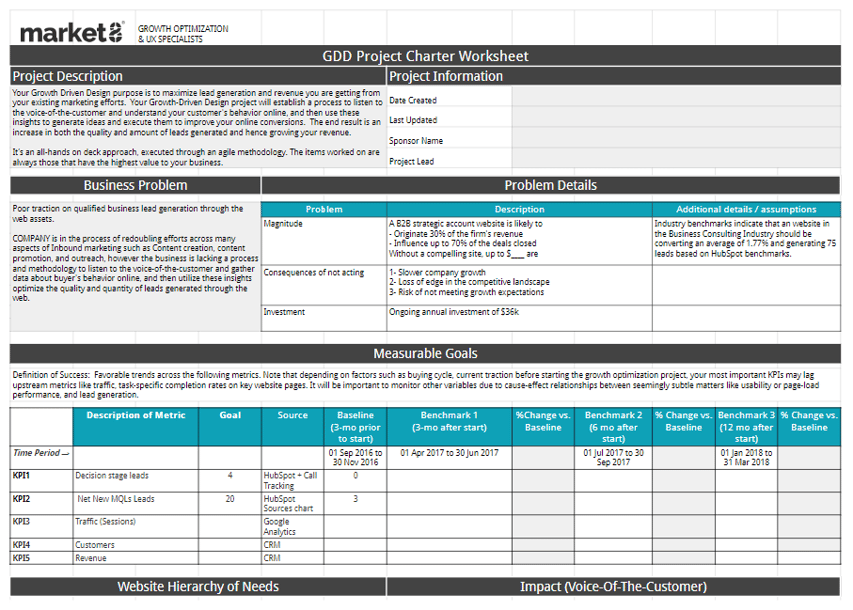How to Convince Your Boss of GDD vs. Traditional Web Design
You have done your homework and are convinced that Growth-Driven Design is the right way to go. Now the next big hurdle is to communicate this to your organization and get your team onboard with the idea.
To craft a solid argument that will win the souls of your boss and key stakeholders, you will need to tackle this communication from different possible angles.
This may seem like a daunting task but we're here to help.

Think about it, you understand the process of creating an offer that works.
Just remember the #1 rule of marketing: Know your audience.
What else? - Frame the problem in a way that your boss can directly see how it relates to his personal goals, and to the company goals. Lastly, build a business case that would be just foolish to overlook.
Think about it, why would selling an idea internally should be any different than selling an offer to your customers?
This article will show you how to sell GDD like a master.
To sell Growth-Driven Design to your boss you have to follow very similar steps to the ones you would follow to sell your company’s product to your buyers. Tweet this quote
QUICK Recap: What is Growth-Driven Design?
Growth-Driven Design is a smarter approach to building and optimizing websites.
Instead of following a one-and-done approach, GDD focuses on launching a site that's better than what you have today (called a "Launch Pad Website") and then continuously improving from there.
“Growth-Driven Design is an investment that produces reliable month-over-month growth. Your website becomes stronger as you continue to measure, iterate and act.” ![]() Click to tweet
Click to tweet
Context: When is the right time to pitch GDD in your organization?
Growth-Driven Design is not a silver bullet, and it doesn’t work alone. However, you can be sure that if you think your company can measurably benefit from a website redesign altogether, then your company is a good candidate for Growth-Driven Design.
Here is a full analysis on what factors can make an organization ripe for Growth-Driven Design. In summary, your company can benefit the most from the Growth-Driven Design approach if it meets the following criteria:
-
It’s past the initial raw-startup stage.
-
Has a product that is proven in the market.
-
Has some track record in Inbound Marketing, and is generating content consistently (or have a plan to generate content consistently).
-
The marketing department has freedom of action and is not being micromanaged by the CEO, Sales, or even the VCs.
-
Your company has a strong customer-centric focus, and values customer input.
-
Your website already attracts some qualified traffic - the more traffic your site gets, the fastest Growth-Driven Design can demonstrate results.
-
Your marketing team has established SMART goals.
Brownie points - your organization is even a better fit for Growth-Driven Design if:
-
Your marketing team and vendors are accountable for specific metrics.
-
Your site is already generating leads from the web and you are trying to improve both quality and quantity of leads.
-
You have broken down marketing goals and have specific expectations for the website performance.
-
Marketing has a specific lead commitment to sales and to contribution to revenue, whether is a lead quota, or a marketing contribution to revenue goal.
Understand how Growth-Driven Design fits in the overall marketing operation
When you position GDD to your boss, you have to be aware of the marketing context. This may be one of many pieces that your marketing team is working on setting up, or improving results from. So for perspective, here is a quick recap of the 6 critical programs that need to be working in sync in your marketing - like a well-oiled machine:
-
Strategic: Establish a company target for revenue, focus target segments, and define a marketing plan that ties measurable growth goals with tactics. Strategic marketing also makes sure that key resources are oriented towards key growth channels - invest where the growth and profits are expected to be.
In addition, establish a mechanism to listen to periodically review competition, and constantly listen to the voice of the customer to gather insights and keep the overarching messaging and value proposition on target.
-
Organic traffic: This program is responsible for bringing qualified traffic to the site by creating content, managing referral sites, seo, and social.
-
Paid programs: Responsible for running all of the paid advertising; e.g. ppc, facebook, display, or specialized programs like Tech Target.
-
Web & Conversions: Maintain the website in good shape and work towards optimizing the conversions from the traffic that's generated through paid and organic traffic programs, and support assets needed for other programs like trade shows. - Also support strategic account development with all kinds of digital assets.
-
Nurture: Responsible for keeping the database warm and nurtured to pass as many qualified leads captured to the sales team and create more opportunities. This function is also responsible of reactivating old leads.
-
Product marketing & enablement: A program responsible of sales enablement and product / program training for salespeople. It’s goal is to prepare sales to properly follow up with inbound leads and turn more of the leads passed on by marketing into opportunities and sales. Including creating, adjusting and monitoring sales messaging from the sales people.
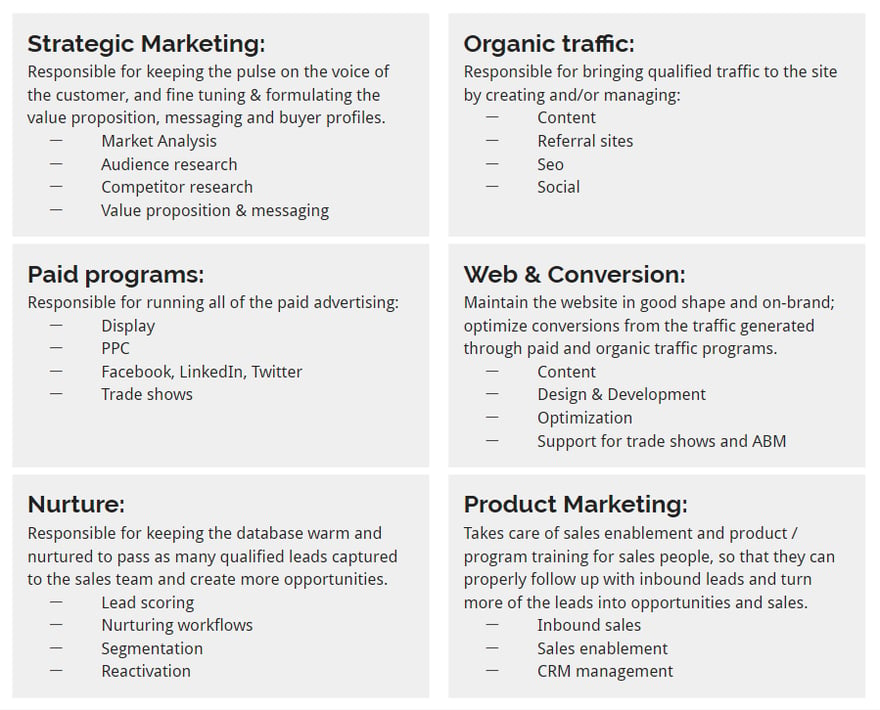
Image credit: 6 Pillars of Marketing
Each one of these 6 areas need specific KPIs and someone accountable for them. Depending on the size of your organization, you might not be able to have one team member exclusively in charge of each program, however it is critical that every program has an owner and is accountable for its KPIs.
Growth-Driven design is the only methodology specifically thought to run a Web & Conversions program. ![]() Tweet this quote
Tweet this quote
There is simply no other process out there that focuses on consistently improving the value your website brings to your company.
Selling Growth-Driven Design to Your Boss
Now that we understand if your company is a good fit for GDD, and how GDD fits in your overall marketing operation, you are ready to prepare a killer argument to get it approved. Prepare your argument in 3 acts:
-
Problem: explain what is the problem to solve.
-
Complication: explain why it is critical to solve the problem, and be clear about the consequences of not solving it.
-
Resolution: Introduce the solution and how it is better than the traditional one-and-done approach.
Let’s go one by one, and provide you some supporting documentation to help you prepare.
Act 1. Problem
Before you jump into presenting all the great things about GDD, you have to get your boss to agree to the problem first. You need to frame the problem from different angles. For this, you need to identify the gaps between status quo and desired state in 4 areas:
-
Goals
-
Importance of the site
-
Website performance
-
Organizational & processes
1.1 Goals: Recap on the goals for marketing and for the website.
-
Understand the organizational-level growth goals - what are the growth ambitions of your company. Answer the following questions:
-
What’s the current overall revenue?
-
What’s the growth goal for the next year?
-
What’s the growth goal in 5 years?
-
What are the initiatives in place to make that happen?
-
How much is marketing expected to contribute to those goals?
-
Understand other key initiatives in the organization that are not directly related to growth but still could benefit from an iterative approach on the site. These kind of initiatives may include for example things that the organization is doing to increase customer satisfaction or efficiencies in key processes:
-
Creating a self service portal for customer service.
-
Creating and knowledge base.
-
Creating a secure portal for customer education.
-
Creating automated application forms such as “open an account”.
-
Understand your boss’ goals - know how is your boss personally measured in the organization. Having a clear understanding of your boss’s goals you will be able to make the link of how the website performance directly contributes to his goals. KPIs for Chiefs of Marketing vary but more frequently they are one of the following:
-
Sales Qualified Lead commits: # of leads that the marketing department needs to deliver to sales (this is by far the most popular measure right now).
-
Sales Opportunities: # of opportunities that Sales generated from marketing leads.
-
Marketing-Driven Revenue: Total dollar amount that marketing deals are adding to the top line either in ARR, or lifetime value.
-
Marketing Contribution to Revenue: Total % of the total revenue that’s a) originated from marketing generated leads, or b) influenced by marketing.
The last 2 metrics here are becoming more popular among growth-driven marketing organizations. Sirius Decisions modeled at a high level what the expected Marketing Contribution to Revenue should be depending on the sales channel and the type of sale.
1.2 Establish the importance of the website to reach those goals.
-
Your website is your biggest marketing asset because most, if not all of your marketing activities, lead to a website visit.
-
Your website is your #1 salesperson. Your website is the first place where qualified buyers will go to learn more about how your product can help them solve their problem. A bad website will make you waste marketing dollars.
-
The more complex your product, the more important your website is--not less.
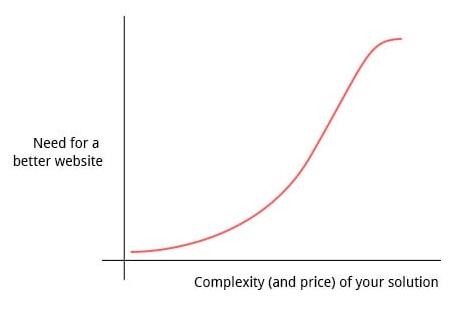
-
Your site is a critical resource for your buyer while in the consideration and decision stages of the buying process.
During the consideration stage, your buyer will perform large amounts of research--your website’s where he’ll do that. Later during the decision stage, your buyer will seek to justify his decision by looking for case studies featuring other happy clients who have done the same. Case studies also live on your website.
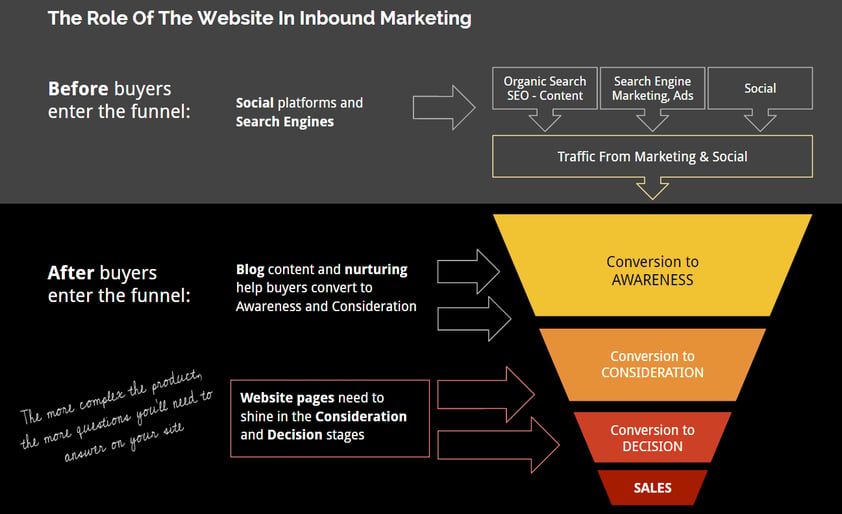
Image credit: Marketing Contribution to Revenue
-
The Ultimate goal of the website is to capture leads: The website’s ultimate objective is to help you capture Marketing Qualified Leads and Sales Qualified Leads. This can only be done through a process of educating your buyers about how your product can help them solve their problems, and capture contacts at different stages of the buying cycle.
-
Beyond buyers, there are other important users of the site: A lot of the discussion is typically centered around the problem of lead capture, however, the website does fulfill other roles that are very critical to the overall success of the company. Some of these other important stakeholders, often overlooked are:
-
Existing clients: Your website still has a role for existing clients, specially around helping you tell the story of how your company can help throughout the customer lifecycle.
-
Employee candidates: Recruiting top talent is a key strategic objective in most organizations. A poor performing website that doesn’t reflect the organization favorably can hurt the company’s ability to recruit top talent.
-
Industry Analysts: If you are a software company, to a great extent, your website influences the perception of industry analysts, and often help them build an opinion about how your solution approaches solving a problem.
-
Investors: If your company is public, investors will have a particular set of interests and motivations that can persuade them to invest in the firm.
-
1.3 Expose the current website performance vs. goals for the website funnel conversions.
Filling up a quick table can drive the point home and make it very clear what the current performance of the site is vs. where it needs to be. Make sure you indicate the kind of programs that need to be run to achieve the goals.
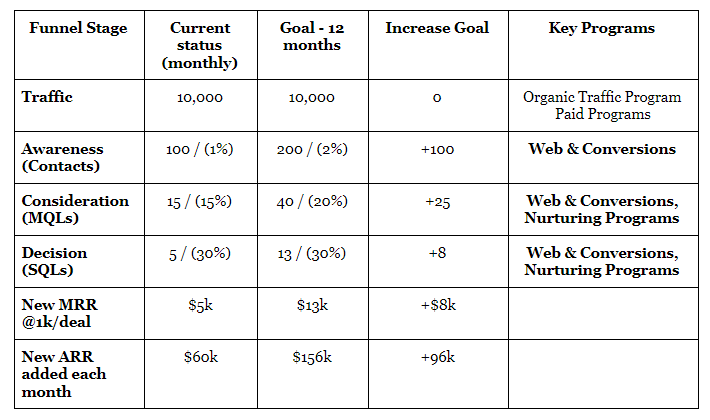
Table: An example of a simple performance vs. goals table for a SAAS company; showing funnel conversion improvement goals without increases in traffic.
1.4 Recognize organizational and process gaps to give the website.
Identify whether or not you have the staff skills and capabilities to tackle a website redesign internally, and whether you have the processes in place to execute.
-
Skillset needs - To create a website that’s expected to perform you’ll need to have a team that’s trained on more than just good visual design skills, including the following:
-
Data analysis through advanced google analytics and google tag manager
-
Conversion Rate Optimization (CRO)
-
Persuasive copywriting for websites
-
UX / Conversion-centered design
-
Website Usability
-
Audience research and data mining
-
Agile / SCRUM process
-
Assess your Growth-Driven Website Grade - This can help you identify overall the likelihood that your website can reach the level of performance, and the maturity of the processes that need to be in place to continue to improve on such performance.

Image Credit: Growth-Driven Website Grader
1.5 Marketing & Sales messaging is evolving.
The market is constantly evolving and therefore marketing and sales messages need to be constantly adjusted. For this to happen, any sales and marketing activity needs 2 things:
-
Feedback from real customers.
-
Iterations, to fine tune based on that feedback.
1.6. All marketing & Sales activities are iterative.
-
When you do a tradeshow, you learn from doing it the first time, and next time you do it better.
-
When you publish content, you can learn from what your buyers read and share the most, then you can tweak your content strategy to cover the topics that your buyers are most interested about.
-
When you launch an eMail campaign, you can see what email subject lines get more opened, and which calls to action get more clicks.
The website performance can also benefit from constant tweaks and iterations. However you need to establish the specialized training and technology that can help you company get insights about what your buyers are doing on your site, what’s confusing them, and help you identify areas that need to be improved, based on actual user behaviors.
1.7 Synthesize the problem statement.
Here is an example of how you can synthesize and frame the problem to your executive team.Soundbites for your presentation:
-
ACME company wants to grow by ___% or $___ in the next __ years.
-
The expected marketing contribution to revenue is ___% or $___.
-
To reach the marketing contribution to revenue goal, we need marketing to produce ___ SQLs.
-
SQLs cannot be produced by marketing without a conversion-oriented website that’s specifically created to maximize the value it provides to buyers, and maximizes lead capture.
-
Our current website conversion rates are ___% (__% under goal, and ___% under industry averages). To meet the projected commitments, website performance needs to increase lead capture rates to ___% (an increase of ___% over current performance levels).
-
Currently we lack the staff expertise, and processes in place to fix the website performance in a consistent manner.
Act 2 - Complication
What happens if the problem of not having a high performing website is not addressed? To accomplish the stated goals of the organization, you can continue the narrative in 3 parts.
2.1 What is the impact to the organization?
First you need to quantify the cost of not having a high-performance website.Soundbites for your presentation:
-
The website conversion performance does not improve from its current levels, the cost of opportunity to the organization would represent a loss of $___ potential revenue over the next __years, considering only website-originated leads.
-
In addition, a poor performing website could impact up to ___% of deals originated through other channels, as the website acts as a positive influencer for most buyers in the consideration and decision stages of the buying process regardless if they were marketing originated or not.
-
To make up for the loss of revenue from the website channel, the company would need to invest in other less efficient lead gen channels, and potentially elongate the sales process.
-
Other consequences of a poor performing website include a poor view from industry analysts and qualified job applicants.
2.2 What is the impact to your boss’ personal goals?
Paint a picture of how a poor performing website would impact your boss KPIs directly.Soundbites for your presentation:
-
Without improving our website’s conversion performance, our ability to meet [Marketing’s contribution to revenue objective of ___% (place top KPI of your boss here)] will not be possible to achieve.
2.3 Establish the need for a website redesign.
Exposing the risks of not doing it in an iterative manner. Soundbites for your presentation:
-
To achieve the conversion performance we need from the website we need to reengineer the website.
-
Redesigning our website using a traditional one-and-done approach might boost performance in the short term, but...
-
If we don’t measure and understand what worked and what didn’t, we are voluntarily signing up for a high-risk, complex project with uncertain return.
-
Leaving the website untouched until the next redesign 2-3 years from now, bounds the website to long periods of underperformance without anybody looking at it.
-
This is not the way to manage what we consider our biggest marketing asset. We need an iterative approach.
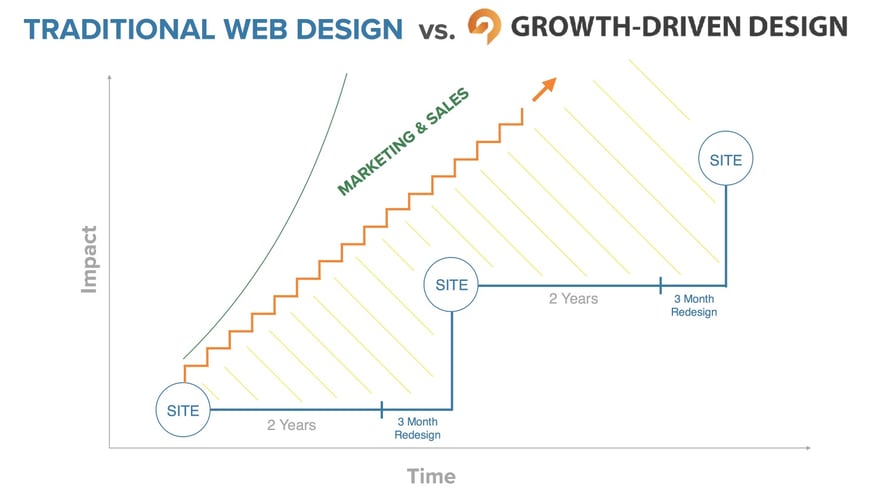
If your boss has been frustrated with website redesigns in the past, you could add to your arguments that website redesign processes are lengthy and frustrating.
Act 3 - Resolution
Once you have established the importance of the website, and made clear the consequences of not improving the performance of your website you can start discussing the resolution.
You can use the GrowthDrivenDesign.com website messaging/content to help guide the conversation, and get your boss familiar with what Growth-Driven Design is and how it works.
3.1 Introduce the solution.
Soundbites for your presentation:
-
Fortunately, there is a proven methodology to redesign websites in an iterative fashion, using data to inform decisions on design, copy, and priorities.
-
This methodology is called Growth-Driven Design: smarter approach to web design that eliminates all of the headaches and drives optimal results using data.
-
Growth-Driven Design is built on-top of the SCRUM agile + lean process.
3.2 Show how does a Growth-Driven Design implementation look like?
Here your job is to give your boss some details about how Growth-Driven Design works.
There is a lot of material about Growth-Driven Design however, some key points you want to mention in your pitch include an overview of each one of the 3 phases, and anticipate some of the questions you will likely get:
-
Strategy phase: understand exactly who are we designing the website for? Who’s the main audience? And what are the key objectives of the website?
-
The Launch Pad: avoid the mistake of doing a lengthy, and expensive full website redesign by launching only the first iteration of the website that fixes the most critical aspects of the site first, and in under 1 - 2 months.
-
Continuous Improvement: Collect specific user data and iterate on the website, always taking care of those items that have the highest chance of impacting our business goals. Continue using data to make improvements to our site.
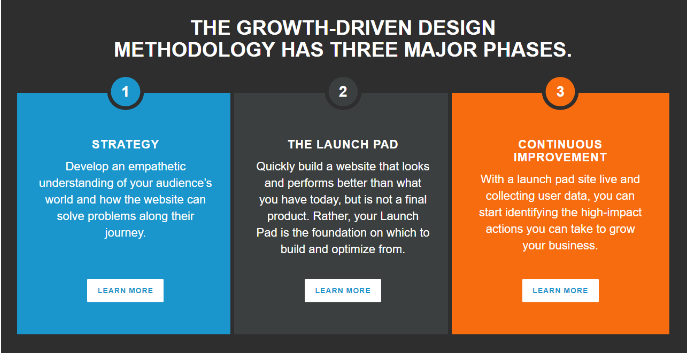
3.3 Show how GDD is different from traditional website redesigns
During your presentation it’s extremely important to draw a sharp contrast between the traditional website redesign approach and Growth-Driven Design. The sharpest the contrast is, the better. Soundbites for your presentation:
-
The Growth-Driven Design methodology is the only methodology that we can use to consistently raise our website’s performance to a level that meets our marketing and business goals.
-
GDD allows us to significantly lower the risk of the website redesign vs. the traditional website design approach by:
-
Launching improvements quicker and at a lower upfront cost.
-
Focusing our work always on the 20% of the issues that deliver 80% of the value, as opposed to doing everything at once regardless of the value to our business.
-
Basing all design, copy and priority decisions based on data, not opinions.
-
Establishing a process to measure what works vs. what doesn’t, iterate and improve, instead of leaving the website alone after launch for years
-
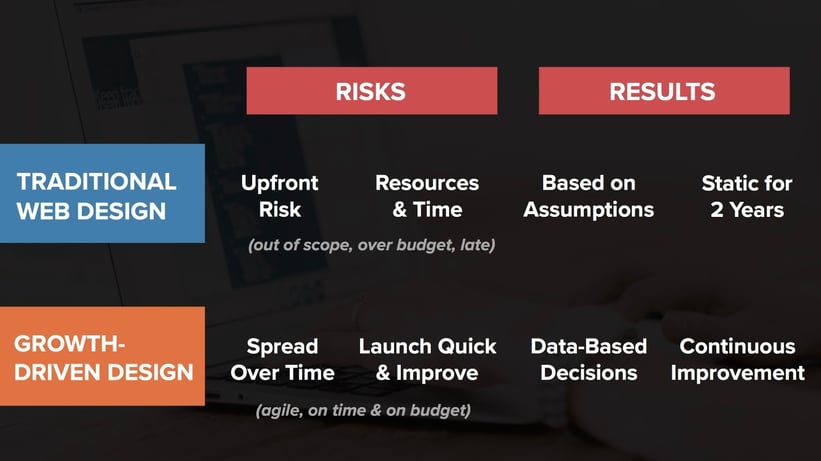
3.4 Show proof that Growth-Driven Design works
There is already some data about how Growth-Driven design is working for other companies. Show your boss some key data points on the results that others are getting using Growth-Driven Design, and dissipate some of the uncertainty around it.
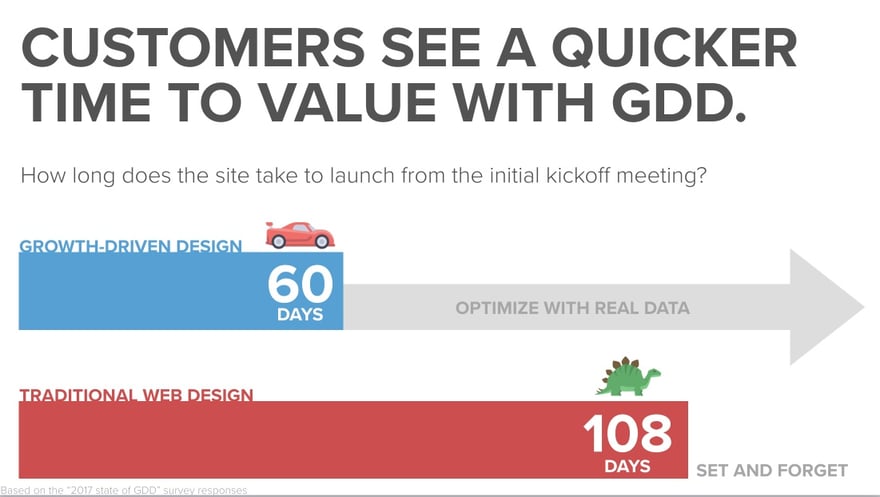
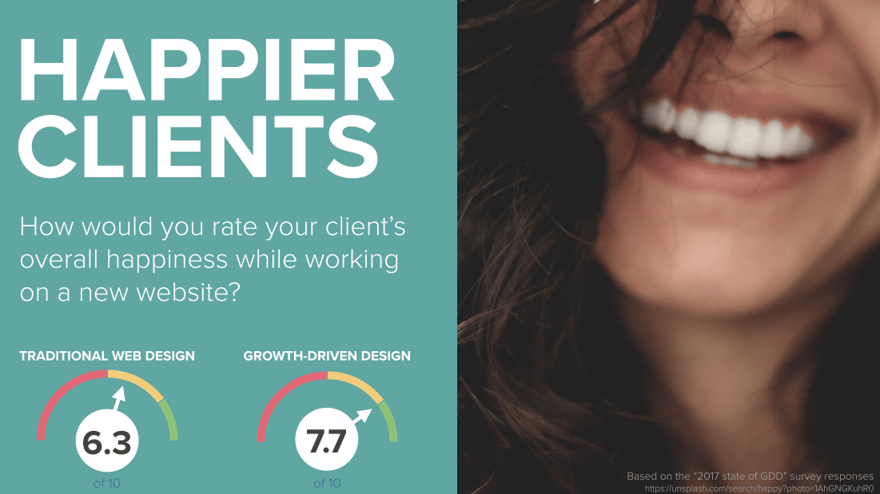
Soundbites for your presentation:
-
Growth-Driven Design drives value faster.
-
GDD drives more business impact vs. traditional redesigns: Companies that use the GDD methodology to redesign their sites see more Visitors, Leads, and Revenue that those using traditional website redesign techniques.
-
Show some specific case studies.
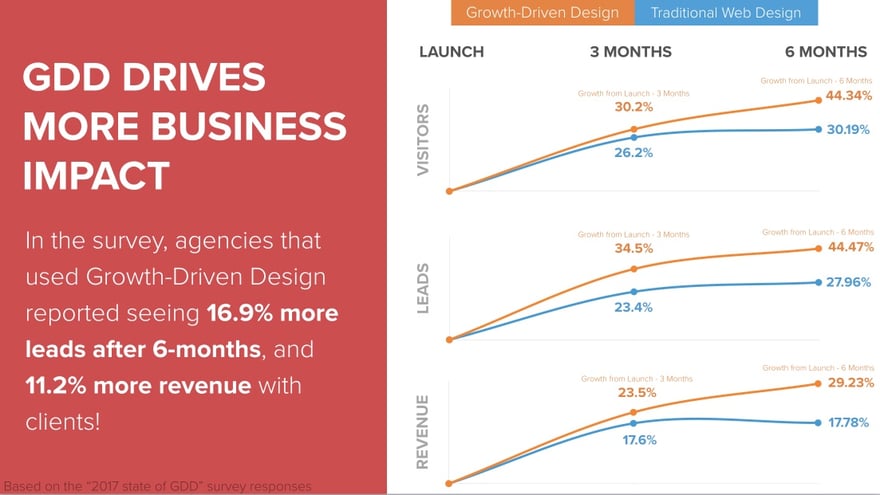
Handle Objections
After presenting GDD to your boss, you’ll need to be prepared to answer at least some of the most common objections.
Line up the ducks. Make it easy to approve.
To get a project approved it’s best to keep things very concise. For this you can put everything together on a 1-page project charter that includes all the key information about the project.
Key information that needs to be in your project charter - maximum one paragraph or a few bullet points to describe each:
-
Project description: Give an overview of the initiative
-
Business problem: Explain what is the business problem that needs to be solved.
-
Magnitude of the problem: quantify the $value of the problem and list the concise consequences of not solving the problem.
-
Measurable goals: create a table that shows the KPIs you will use to track the progress of the project, as well as the goals and the definition of success in terms of these KPIs.
-
End-User Impact: Explain in simple terms what impact will the project have on the end users; how will their experience with the company be different.
-
Key Deliverables: List the kind of things that will be done as part of the project
-
Prioritization Criteria: What’s the criteria that will be followed to decide on priorities for what should be worked on first.
-
Out of Scope: Avoid misunderstandings by defining what kind of activities, are out of the scope of the program; make sure to list that could be easily confused as part of the scope.
-
Risk factors: You will need the buy-in and participation from other team members. Make sure to mention key areas that the project depends on: finance, sales, CMO approvals, etc.
-
Overall roadmap: list a few of the key milestones such as date of completion of the initial research, and the release of the launchpad.
-
Team members: list the core team and their roles in the project and their contact info.
-
Stakeholders: list other key stakeholders who may need to be involved on the project.
Top mistakes when selling GDD to your boss.
Here are some key mistakes you need to try to avoid when selling GDD internally.
-
Not doing your homework: Whenever critical information and context is missing, humans gravitate towards the only tangible measure available to them (usually price). Make sure you spend some time understanding the overall company goals, your boss’ goals and link goals and the problem to the solution.
-
Not separating the business problem from the budget discussion: Focus on getting your boss to understand what is the business problem to solve first - how the website plays into it and get excited about the concept of GDD.
-
Not being prepared to handle objections: The most common objections to GDD are well known now. You can download an objection handling sheet here, and you can ask peers in Inbound.org’s Conversion Channel, or join the Growth-Driven Design community in slack.
-
Waiting until a website redesign initiative is on the table: Unfortunately in most companies the discussion of GDD is commonly started when there is an intention to do a website redesign. A typical process to buy website redesign projects is a bid process, asking a handful of web design firms for proposals based on some guidelines.
This is not the ideal time to present the idea of GDD. If your company is in this situation already, try to back up your team and elevate the conversation to have your boss think through the objectives of the website redesign, and help him realize how these objectives can be better achieved with GDD.
Additional Resources
Conclusion
Once you understand the power of Growth-Driven Design, the next big job you will need to get done is to sell it internally. As in any kind of big ticket item you need to sell internally, you need to be prepare well and justify your recommendation.
Like Gary Vaynerchuck once said: “I don’t convince people - I just sell stuff to the already convinced.” So the best way to sell GDD to your boss, is not to do any selling actually. Simply understand your boss’s goals, as well as the goals of the company, and think about how to position GDD as a natural needed step to achieve their goals.As a recap, you need to:
-
Understand the context: When is the right time to pitch Growth-Driven Design in your organization?
-
Understand how Growth-Driven Design fits in the overall marketing operation
-
Sell GDD to your boss in 3 acts:
-
Act 1 - Problem: What is the business/marketing problem to solve.
-
Act 2 - Complication: What are the consequences of not dealing with the problem
-
Act 3 - Resolution: How does GDD solve the problems and impact the business.
-
Handle objections - leverage the experience in the GDD community.
-
Make it easy to approve using a 1-page project charter.
If you structure your recommendations following the guidelines in this article, you will have a decent shot at getting it approved.
What about you?
Have you sold Growth-Driven Design (or actually, any big ticket marketing initiative) to your boss? What have you done well? What would you do differently if you had to do it again?
Please comment...
Topics

Eduardo is the Founder and Chief Web Architect at Market 8. Under his leadership, Market 8 has generated 50+million in additional sales annually for 200+ B2B companies. Eduardo has a very eclectic background; a renaissance man, in a way. How eclectic? He’s a Georgia Tech Industrial Engineering Masters graduate, turned manufacturing plant & distribution network designer, turned business management consultant, turned financier, turned M&A analyst, turned entrepreneur, turned CMO, turned web design & UX expert and angel investor. Specialties: Strategy, systems design, business turnaround, B2B lead generation, B2B sales, conversion optimization, user experience, information architecture, human-factors.



